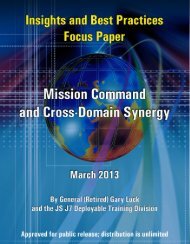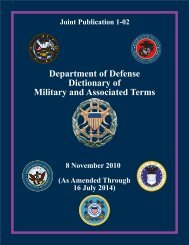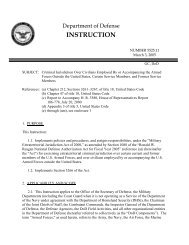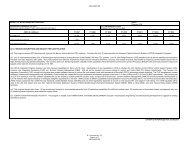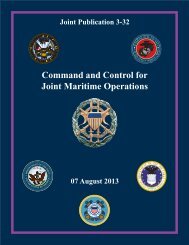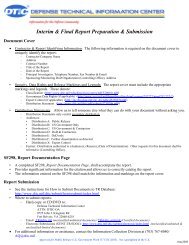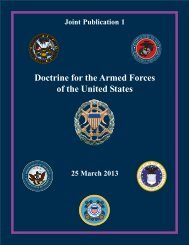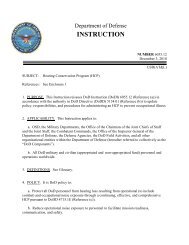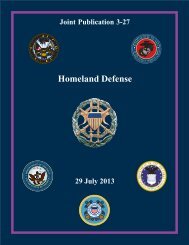JP 3-16, Multinational Operations - Defense Technical Information ...
JP 3-16, Multinational Operations - Defense Technical Information ...
JP 3-16, Multinational Operations - Defense Technical Information ...
Create successful ePaper yourself
Turn your PDF publications into a flip-book with our unique Google optimized e-Paper software.
Appendix C<br />
oversight, and direction to the standing and directed multinational interoperability working<br />
groups (MIWGs).<br />
(2) The MIC consists of two standing MIWGs with different scopes; the operations<br />
and the operations support working group. The operations MIWG focuses on issues<br />
associated with current and future coalition operations from a cross-functional perspective.<br />
The operations support MIWG is task oriented and focused on operational enablers in<br />
support of coalition operations. Directed MIWGs are stood up on the direction of the<br />
principals to address a specific or a group of specific tasks. A directed MIWG is time<br />
limited with an expected duration of 12 months; continuation will be reviewed annually.<br />
Each MIC nation provides at least one representative (O-6/O-5 - NATO OF-5/OF-4) to each<br />
of the MIWGs. Through analysis of national positions with respect to concepts, policy,<br />
experimentation, lessons learned, doctrine, and other relevant areas, the MIWG’s aim is to<br />
inform and support coalition building and operations and influence the development of<br />
operational practices to enable more effective coalition operations.<br />
(3) The MIC Executive Secretariat (ES) staff is the only full-time MIC staff and<br />
works in the US Joint Staff <strong>Operations</strong> Directorate in the Pentagon. The MIC ES staff is<br />
responsible for managing and coordinating the day-to-day business activities for the MIC<br />
while serving as the central point of contact for the MIC Principals, the SG, and the<br />
functional MIWGs. In addition to permanently assigned US personnel, two non-US officers<br />
from other MIC member nations are assigned full time to the MIC ES staff. The MIC ES<br />
staff conducts all external coordination, correspondence, and communication with the staffs<br />
of non-MIC nations and organizations as well as other combined multinational organizations<br />
on matters of mutual interest to the MIC: ABCA Standardization Program, ASIC,<br />
AUSCANNZUKUS, CCEB, NATO, Quadrilateral Logistics Forum, and the <strong>Technical</strong><br />
Cooperation Program.<br />
d. Other nations and organizations can participate in MIC activities as affiliates or<br />
observers to address common interoperability issues. Affiliates have an enduring, ongoing<br />
relationship with the MIC. Observers are nations/organizations that attend MIC meetings on<br />
a one-time or short-term basis to support a specific event or activity that addresses<br />
interoperability challenges or leverages ongoing MIC activities. Currently New Zealand,<br />
NATO Allied Command Transformation, and the Military Staff of the EU are MIC affiliates.<br />
3. Accomplishments<br />
MIC-developed documents represent a nonbinding consensus view among MIC nations.<br />
These documents are reviewed and updated on a regular basis. The following are<br />
representative examples of MIC-developed documents. Refer to the MIC community on the<br />
All Partners Access Network (APAN) Web site for the most current version of all MIC<br />
documents.<br />
a. Coalition Building Guide (CBG)<br />
(1) One of the MIC’s early actions was the development of the CBG. The purpose<br />
of the CBG is to facilitate LNs, troop contributing nations, and participants in the<br />
C-2 <strong>JP</strong> 3-<strong>16</strong>



